.
19TH
CENTURY
SHIP PORTRAITS IN
PRINTS:
AQUATINTS, LITHOGRAPHS
AND
ENGRAVINGS
SOME OF THE MASTERS
THE MEDIA
AQUATINT is a print making
technique, a variant of
etching. It is
called aquatint
because the
finished prints
often resemble
watercolours or washed
drawings. The
technique involves
exposing a copper or zinc plate
to
acid through a layer of
resin melted by heating the
plate.
As in
engraving a
needle can be used to
make lines. The
acid bites
the plate in the interstices of the resin which
leaves an evenly pitted
surface when the resin is removed
and the plates
are used
for printing.
Aquatint became popular
with the illustrators in
the
eighteenth century. Jan van
de Velde, the
Dutch painter
and print maker,
invented the aquatint
technique in
Amsterdam circa
1650.
LITHOGRAPH is
a
print making process
based on the
immiscibility of grease
and water - they
don't mix. The
technique originally
used was an
image drawn into a
coating of wax on a
limestone plate as a way
to transfer
ink in the printing
process. It is different from other
gravure technologies
where the plate is
engraved, etched
or
stippled to score cavities to retain the ink,
and was
cheaper and easier than other techniques.
The process was
discovered in 1798 by Alois Senefelder
of Munich who used a
porous
Bavarian
limestone for
his plate.
"Lithography" is from the Greek
"lithos" for
stone.
The secret of lithographic
printing was closely
held until 1818 when
when
Senefelfelder published
details of
the process.
ENGRAVINGS is a technique
for making
prints from
metal plates in
which a design has been
incised. The
technique originated in
nortern
Italy in the fifteenth
century.
(Sources: Wikipedia and Encyclopaedia Britannica)
INDEX
OF SHIP IMAGES DISPLAYED BY NAME IN
ALPHABETIC
ORDER .
ABC-DEF-GHI-JKL-MNO-PQR-STU-VWXYZ
To see other ship
portraits:-
http://www.spurlingandrouxwatercolours
-
watercolours
by Jack Spurlin of sailing
ships and by
Antoine Roux and
his
three sons of
sailing ships and Mediteranean craft
http://www.findboatpics.net - sailing ships in the
Australia
&
New
Zealand trade 1840-1880s
http://www.findboatpics.com.au
- steamships in the
Australia and New Zealand
trade,
1850s - 1914
http://www.findboatpics.net.au
- steam and motor ships
in the Australian and
New Zealand trade 1918 - 1970s
I. AQUATINTS
- EDWARD DUNCAN
1803-1881
AFTER WILLIAM JOHN
HUGGINS
1761- 1845
WILLIAM JOHN
HUGGINS as a young man went
to sea in
the Honourable East India Company's ships.
He is
believed
to have learnt to draw in China. On
what may have
been
his last voyage,
he was steward
and assistant
purser on the Company ship
Perserverance
which sailed for
Bombay and
China in Dec.
1812, and
returned in Aug.
1814 Shortly after he
set up as a
marine
painter near the offices of the East India
Companyin London
specialising in
ship portraits.
Many
of his paintings
were engraved as aquatints by his
son-in-law,
Edward Duncan.
Huggins was first exhibited
at the Royal
Academy in
1817 and regularly
after that.
as well as at
the British Institution. In
1836, he was
appointed
official marine painter
to King William IV.
He was a
prolific painter and painted ships in action
or incident
rather
than in broadside profile. His
work was popular
with the public and
seafarers.if
not
always with the critics.
EDWARD DUNCAN,
as an apprentice to Robert
Havell, trained
as an aquatint
engraver. He married
Huggin's
daughter and from 1826
engraved his
father-law's
works. He was
also an accomplished
watercolourist
and exhibited at the New
Watercolour Society
and the
Royal Academy.
In
1843 he engraved for
the Illustrated London News.
His focus on
marine subjects resulted from his long
association
his father-in-law.
(Sources: "Dictionary of
Sea Painters" by
E.H.H. Archibald
and the "Dictionary of
Marine
Artists" by Dorothy
E.R. Brewington)
EDWARD
DUNCAN'S AQUATINTS AFTER
WILLIAM
JOHN HUGGINS
(IPHD)
Reefing Topsails
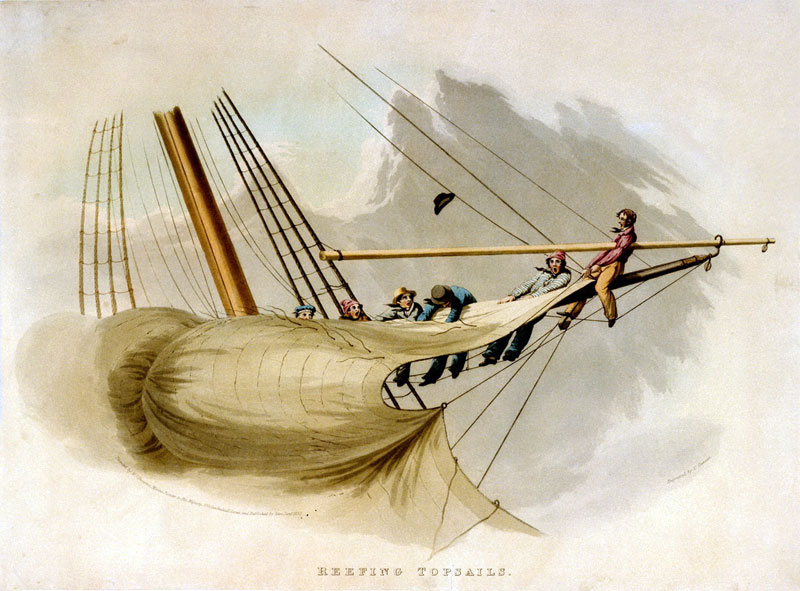
E.Duncan
after W.J. Huggins
Aquatint, 1832
Royal Museuns
Greenwich, London (PW3760)
II.
LITHOGRAPHS
The Great Tea Clipper Race of 1866:
the Clipper Ships
'Taeping' & 'Ariel'
passing the Lizard 6
September 1 on
their
homeward voyage from Foo-Chow-Foo.
.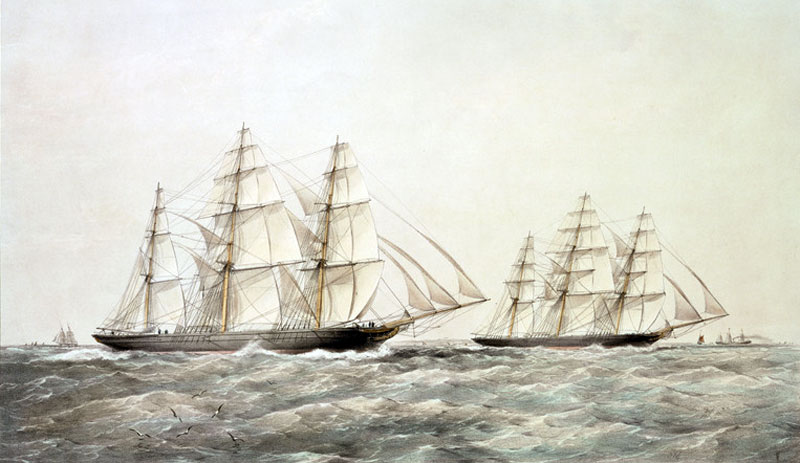
Artist and engraver
Thomas Goldworth
Dutton
Coloured lithograph: 1866
Royal
Museum Greenwich,
London (A7187)
1.
THOMAS
GOLDWORTH DUTTON
(c.1819-1891).
Active
as an artist and lithographer in the years 1844-1878..
In 1844,
he described himself as a "Lithographic artist,
marine draughtsman,
and draughtsman on wood." His
lithographs appear
to have had their origin in water colours.
He was
an engraver
but appears to have left the printing
and hand
colouring to
others for much of his work, e,g. to
Day
& Son, for many years.
His publisher through most
of his
career was William Foster who
in
the later years
dedicated some of his work. He also exhibited at the
Suffolk
Street Galleries between 1858 and
1859.
There
are a snall number of lithoraphs engraved by
Dutton
of paintings by other
artists.
There are several
displayed in
this
website, e,g., the steam
auxiliary
'GREAT
BRITAIN'' made in 1852 from a
painting by
Samuel
Walters, the clipper
'SCHOMBERG' which was
wrecked.on
its maiden voyage in 1855 from a painting by
G.H. Andrews., and a painting of 'H.M.S. CALEDONIA
120guns, lying in Plymouth Sound' by H.A. Luscombe.
.
E.H.H.Archibald in his "Dictionary of Sea Painters"
describes Dutton
as "not only the finest 19th century
lithographer of shipping
scenes and ship portraits but
happily
the most prolific." The
lithographs depicted
below
are mainly of ship portraits
which
would have
been
commissioned by ship owners (notablythe
Green's
Blackwall Line and Anderso, Anderson's Orient Line
and
ship's captains and are mostly broadside images.
Three in
this website
stand out
- 'SUTLEJ' in a
hurricane, 'CONSTANCE' off
Kerguelens Land and
'LADY
MELVILLE'' passing through icebergs.
He also
made a large number of lithographs of ships
of the
Royal Navy and naval
activities and actions.
e.g. the British
and French fleets in
the Balyic,e.g., the
war in the
Crimea, and also a large
number of no doubt
commissioned lithographs of
yachts and yacht
races,
(Sources:"Dictionary of Sea
Painters" by
E.H.H.
Archibald and "Dictionary
of Marine Artists"
by
Dorothy E.R. Brewington)
The
author
is indebted to the Royal Museum, Greenwich,
and the
Australian National Library, Canberra, for their
assistance in
providing most of the images displayed.
A.
The
Blackwall Frigates (LPTGD-BF)
Nearly all these ships were in the Indian and
Australia/New Zealand trades.
B. Other
Clippers (LPTGD-OC)
D. Steam and Steam Auxiliaries (LPTGD-2)
E. Royal
Navy Ships (LPTGD-RN)
The East
Indiaman 'SUTLEJ' in a hurricane.
off
the Cape of Good Hope on the Morning of
April Ist
1848 at 3.30 am.
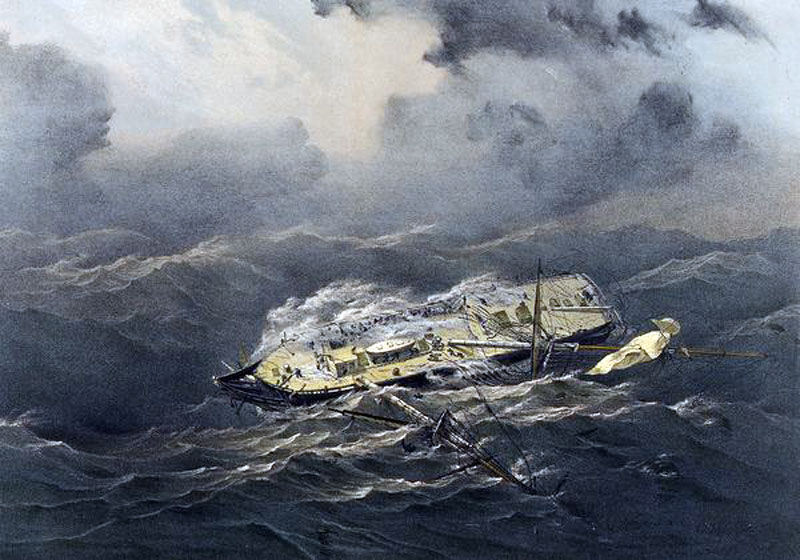
T.G. Dutton, artist
Day & Son
William Foster
Coloured lithograph:
circa 1848
Royal
Museums Greenwich, London (0601)
2.. JOHN
RAPHAEL ISAAC, died
1871
(LPJRI)
JOHN RAPHAEL ISAAC,
draftsman,
lithographer and
painter lived
and worked in
Liverpool. Listed in Gore's
Liverpool Directory in
1839 as anengraver,
printer. In
the same Directory
1841-67, he is listed as a draftsman,
engraver and
lithographer, and
in 1867 as a dealer in
works of
art. (Source: "Dictionary
of Marine Artists" by
Dorothy E.R.
Brewington)
RED JACKET. Inscribed:
"Clipper ship Red Jacket
Captain
Reed of the White Star Line
of Australian
packets. Among
ice on her passage from Melbourne
to
Liverpool ...27th August
1854.".
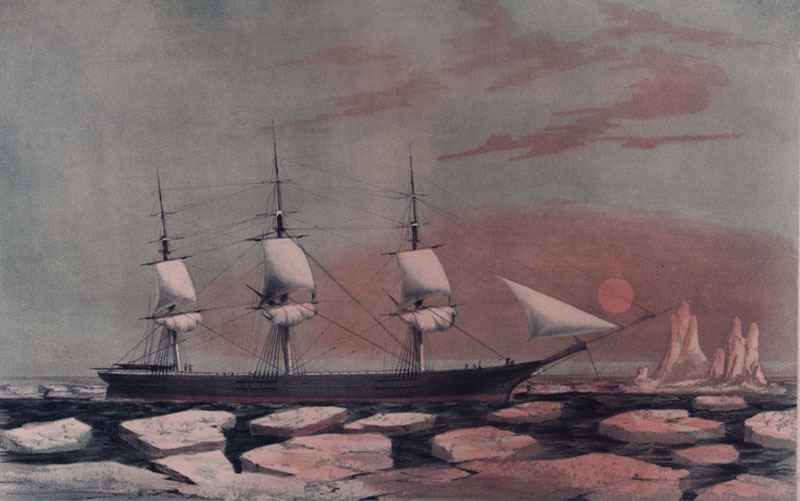
![]()
J.R. Isaac, artist,
engraver & publisher
Coloured
lithograph
Royal
Museums
Greenwich,
London (PY8538)
3.
NATHANIEL CURRIER 1813-1888
Nathaniel
Currier was
born inRoxbury, Massachusetts. His
father died when he was aged
twelve, and at the
age of
fifteen
he
was apprenticed
in
a Boston lithography shop. In 1833 at
twenty years of age he
moved to Philadelphia to do
contract
work
for an engraver and
printer. In 1834, he entered a
partnership with
a New York
print maker, and a year later
ended
the partnership
and worked alone as "N.Currier,
Lithographer". In
1835, he
created a
lithograph of a fire
in the New York
business district of which he sold
thousnda
of copies. He
produced other prints
of disasters and local
and national events and gained
attention
as a
lithographer. In 1840,
he
produced a lithograph of a fire
on
the steam boat LEXINGTON
in Long Island
Sound which
led
to the offer of a
weekly insert in the New
York Sun. As
result, Currier's firm began
a move from job printing to
independent
publishing.
The firm of CURRIER & IVES was established in 1857
when
Currier invited his company's
bookkeeper and
accontant,
JAMES
MERRITT IVES 1824- 1895
to become his
partner.
Ives
became General
Manager of the firrm handling the
financies. He also
had flair for discerning
popular interests
and
participated in
the choice of images for
publication. Some
7,000
lithographs were published in the firms 72 year history.
Artists produced two to
three new images every week for 64
years
(1834-1895) and
produced more than a million
prints by
hand-coloured
lithography. Many
celebrated artists of the
day were
employed or their works used. Lithographs were
produced on
lithographic limestone printing
plates on which the
drawing was done by
hand.
These drawungs were made by the
artists who are
described on the lithographs
as "Delineators"
or
"Del." for short on the
prints.
Early lithographs were
printed in black Prints
were then hand-coloured
by a dozen
or
more
women working in assembly
line fashion, one colour per
worker,
who
received $6 for every hundred prints.
Currier died in 1888, Ives remained with the firm
until
his
death
in 1895. Both
Currier's and Ives' sons
entered the
business which was
liquidated in 1907. Public demand for
lithographs was diminishing
as photography and other
techniques of printing
were developed.
(Source: Wikipedia)
A. Clipper Ships and
Other Sail - (LPCI-1)
B.
Early Steamships - (LPCI-2)
The
author's thanks
to Ms Vanessa Rudisill Stern's public
service
website:
Gallery of Currier & Ives
Lithographs
(http://freepages.rootsweb.ancestry.com/-vstern.index.html)
for permission
to include a number of images of hard to come
by
Currier & Ives
lithographs on this website.
RED JACKET -Clipper Ship
"In
the ice off Cape Horn in
her Passage
from Australia to Lverpool"
.
.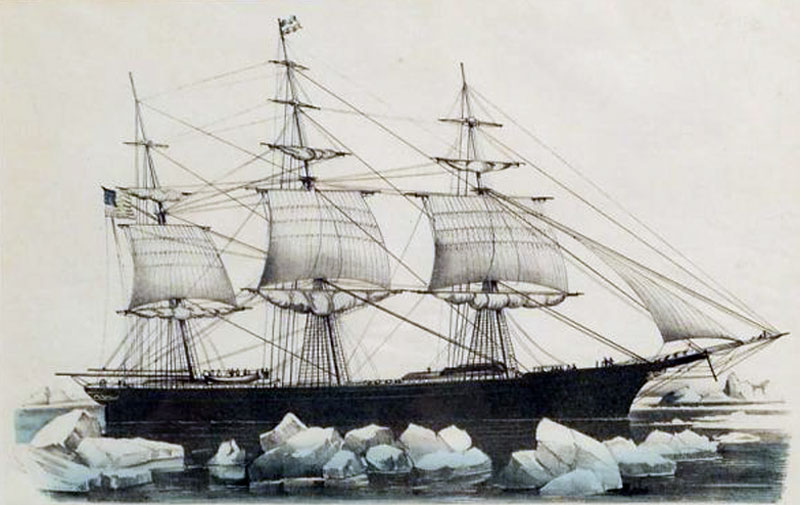
Published by Currier & Ives
C1166 G1282
Vanessa Rudisill Stern's
Gallery of Currier
&
Ives Lithographs
IV.
ENGRAVINGS
Illistrated London News -
A
Selection.
The Illustrated London News
which began publication in 1842
was
the world's first fully
illustrated weekly
newspaper. Its
illustrations were obtained
from wood engravings and
the
popularity of the
weekly attracted artists and engravers such
as
T.G. Duttonand Edward Duncan
above
who
both did work
for
the weekly. In the
age when photography was in
its
infancy
the many ship portrayals in the weekly are a valuable
record of vessels like the Great
Britain in its many early
phases, Marco
Polo, JamesBaines
and some of the
other
Amerian and Canadian built
ships of the eighteen forties and
fifties. Also, often
more accurate than the paintings of them
which
were done of them. The
engravings of
early
steam ships
are of
particular value as the
only pictorial record of many
of
them..
A. Sail
(lPILN-1)
B. Steam (lPILN-2)
The
author is indebted to the
Mary Evans Picture Library,
London
(http://www.maryevans.com) for permission to publish
images
of engravings from the Illustrated
London
News of the
19th
century in the database of
the Gale News Vault in this
website.
GREAT
BRITAIN -after her !852
refit
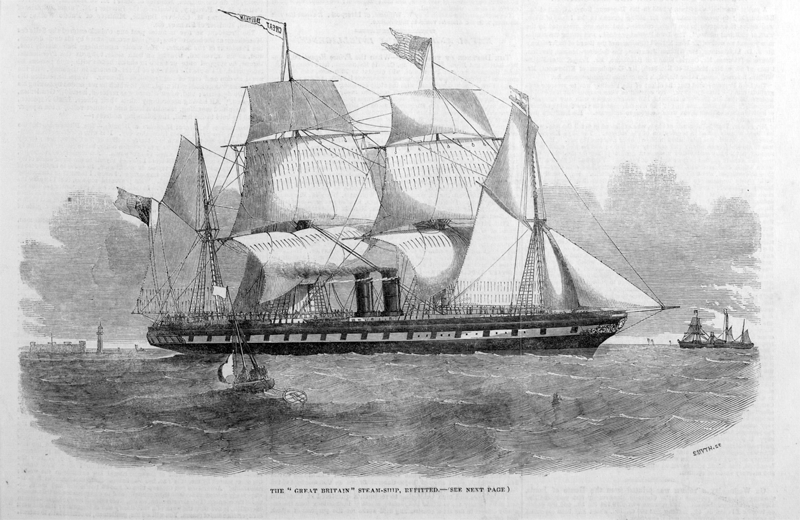
ILN,
Vol.20. 1852(Jan-Jun),
pg165
Mary
Evans Picture Library
THANKS
This project would not have
been possible without the help of:
a. the Image Library of
the Royal Museums Greenwich, London,
with many
images of aquatints of Edward Duncan after
William
John Huggins and lithographs of Thomas Goldworth
Dutton
and John Raphael Isaac;
b. the Mary Evans
Picture Library for the use of engravings from
the
Illustrated London News going back to the eighteen fortie;
and
c. Vanessa Rudisill
Stern's Gallery of Currier & Ive lithographs
for
access to many hard to find images of their lithographs.
The author also wishes to thank
Josephine Hennock for
her assistance in the fashioning
and editing of this
website
and his wife
Janette for her advice, encouragement and
interest while this website was
being put together.
CONTACT
The
author would
welcome correction of mistakes and as
well as comments.
He can be
contacted by email at:
roy@19thCenturyShipPortraitsInPrints.com





